
Homestead Update: Starting the New Garden
Hey friends! It’s been a couple months since we last checked in with a new homestead update… and we’ve accomplished SO much in that time! Planted fruit trees, landscaped a new hedgerow, worked on irrigation, removed some existing plants… and perhaps the most exciting of all: broke ground on the new main raised garden bed space! That particular project is nowhere near complete (it will be a large and ongoing one), but we’ve made some really stellar progress that I’m excited to share with you today.
So, let me show you what we’ve been up to! You know me: I’ll share my thought process, lots of photos, details on the materials we used, and drop plenty of helpful tips and resources along the way. Also, get ready for quite a few kitty pics! We’re absolutely smitten with the barn cats we adopted with the property, and I think they love us back.
I hope you enjoy following along – and learn a few things too!
In case you missed the previous updates:
- A Brand New Chapter: We’re Moving!
- Chicken Coop Deep-Cleaning & Makeover
- Homestead Update: Our New Grow Room
- Full New Property & Garden Tour (video)

Fruit First
If you’ve read our “how to start a homestead” guide, then you know one of the things I recommend doing in any new homestead or garden journey is to plant fruit trees early on. Unlike veggies or herbs, trees can take many years to mature and bear fruit, so it’s great to get them in the ground (and feeding you) as soon as possible. Once established, they’re often far less work than a veggie garden too!
So far, we’ve planted four avocados, two fig trees, a fuyu persimmon, two Meyer lemons, two pomegranates, two pineapple guava, a lemon guava, and a dwarf weeping mulberry. Figs, lemons, and mulberries are self-fertile, but the pineapple guava, avos, and pomegranates will bear far more fruit with a partner around for cross-pollination. Avocados do best with a mix of Type A and Type B avocados around, such as a Hass (type A) and Fuerte (type B).
Many of the new additions were planted in a new hedgerow we created along the southwest corner of the property, while a couple of the trees went into the existing orchard. We planted the avocados in a big open space on the far northeastern property line, which will grow in to provide a fantastic living privacy screen from the modestly busy country road on that side.
We also inherited a few established fruit trees with the property: a mature apricot along with some younger peaches, apples, and citrus. I still want to add pears, plums, and many others with time! What edible trees are on your future dream list?






Clean-Up on Aisle Brick
You know that curvy brick pathway in the center of the existing garden? The one that was once lined with blooming purple catmint? Well… we dug out all the catmint. I know, I know. It was really romantic and dreamy… for the three months or so out of the year it flowered. Yet as the flowers faded, it quickly became an overgrown mess of brown. Catmint needs frequent pruning to prolong blooms, and also needs to be fully cut back to the ground every winter. That was simply too much work for us to maintain looking nice – especially 50+ feet or so of it, times two for both sides of the path!
Maintenance aside, another issues drove us to eliminate the catmint. The catmint became severely infested with sage leafhoppers, which started to spread to other plants in the garden. Leafhoppers are sap-sucking pest insects that damage plants by piercing and sucking nutrients from leaves. They are incredibly difficult to control in an organic manner, and removing the host plant (aka, the catmint) is one of the key ways to knock down their numbers. In addition to digging out the plants, we also released green lacewings in the area – a beneficial insect, and natural predator of leafhoppers along with aphids, mealybugs, and spider mites.



And now, the part you are likely waiting for most…
The Start of the New Raised Bed Garden Space
When gazing out at our soon-to-be new garden area, it was easy to feel overwhelmed at first. First of all, the space is pretty huge – nearly 140 feet long by 60 to 40 feet wide (getting more narrow at one end). It was a blank slate, but not necessarily the most inspiring kind. Nothing but dirt, knee-high weeds, gopher mounds, holes and uneven ground. I had a long-term vision developing, but… where to start? One step at a time.
As you continue reading, keep in mind that we followed very similar steps as we built out our previous front yard garden space – without the help of heavy machinery, just by hand and wheelbarrow, and even had to remove grass first – so all of this easily applies to smaller gardens too!

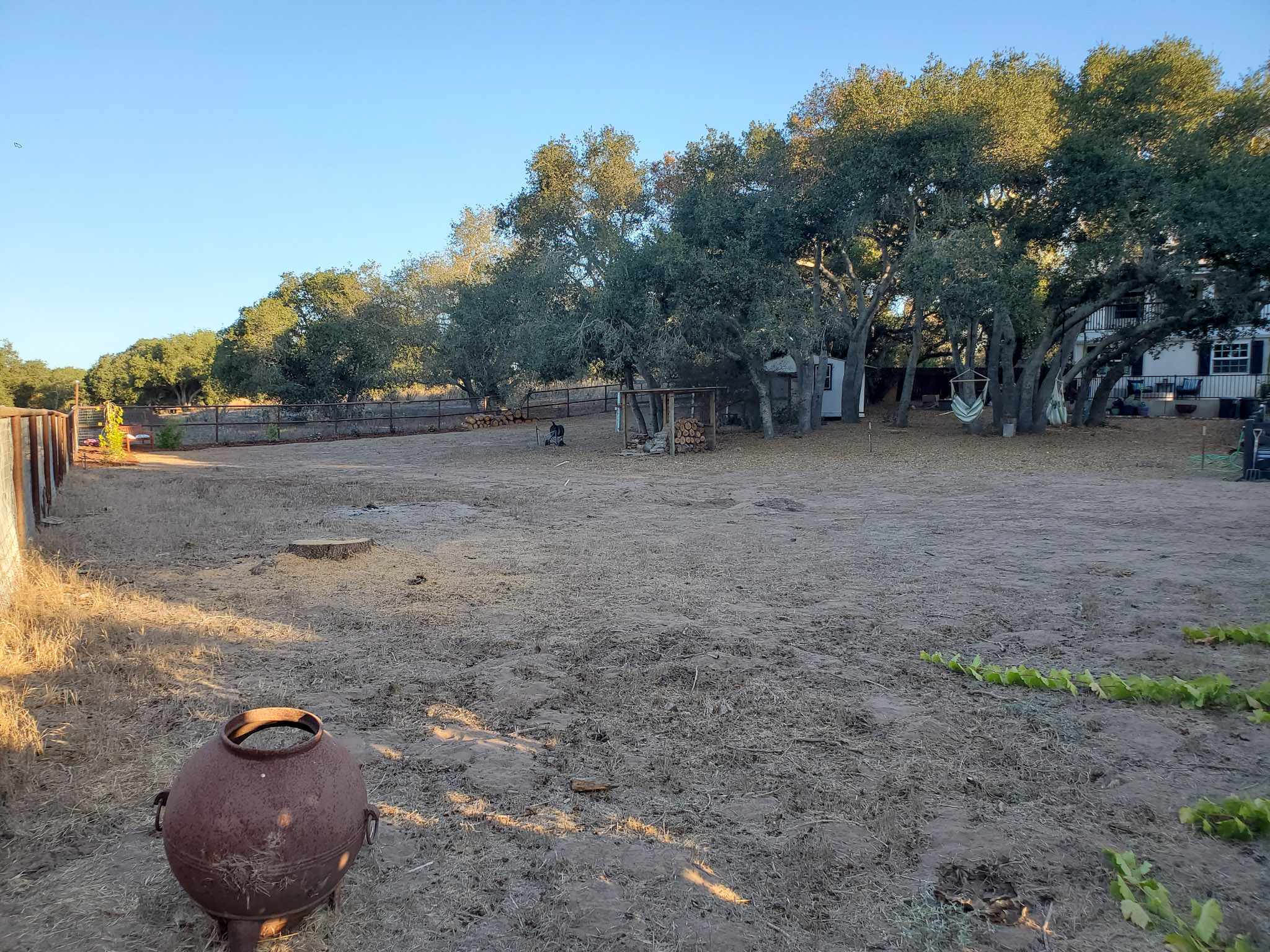
Step 1: Weeds Be Gone
My mom came down to visit from Washington just after Labor Day, and she unknowingly got the ball rolling on the whole project. Like me, she likes to keep busy and moving. After she’d finished weeding a few planters around our patio area, she asked where to weed next. I looked around and said, “Well, I guess let’s head down there” and pointed to the open field where the garden would go. So all three of us grabbed gloves, hats, and buckets to fill – and set off to start pulling weeds by hand. Yes, pulling weeds by hand in a big field may seem silly, but it was quite therapeutic! We don’t have a ride-on mower, and even if we did, that side of the property wasn’t accessible for small vehicles (yet).

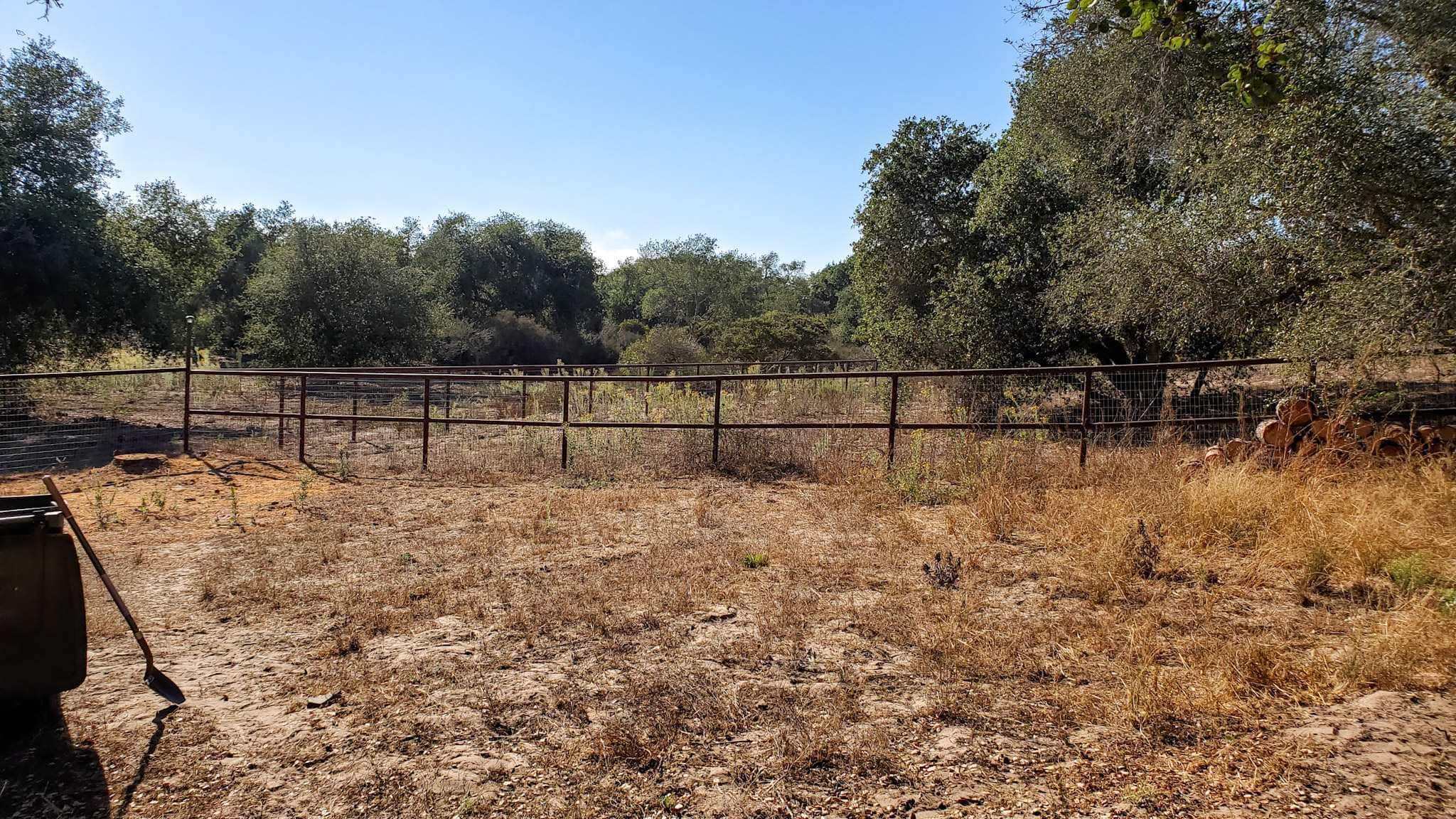

Once the wedding was done and Mom had gone home, we rehabbed an old irrigation system and planted a hedgerow along the far fence. Those few plants and fresh mulch made the whole corner pop! Yet hauling over heavy potted plants, bagged soil and bark for this very modest-size project (in comparison of what was to come) made us quickly realize we needed more help… but not mom help. It was time to look into getting our first heavy machinery for the homestead.

Step 2: Dirt Bowl
The next logical step was to level out the ground some, including filing a large bowl or depression right in the middle of the future garden. I did a quick calculation and determined that 6 yards of bulk fill soil should do the trick. Around that time we also started looking into used UTVs (Utility Task Vehicles) locally. A tractor would have also been helpful for all the earth and gravel-moving this project will require, but a cart or UTV will be the most versatile and useful for us long-term. We were able to test and then purchase a used Kubota RTV, and we love her already! Her name is Dusty.
In order for Dusty to drive over to the new garden area, we first had to remove a section of the black vinyl fencing that surrounds the existing garden and orchard in the center of the property. I do like that space, but it definitely splits up the property in a way that isn’t the most accessible or free-flowing at times. Once that was opened up (but still a very tight squeeze!) we loaded Dusty up with the bulk soil that had been dumped in the front driveway, shovelful by shovelful and load by load. Once all the soil was moved to the back, we spread and leveled the area with hard rakes. I also leveled other areas, spread gopher mounds, and picked up large sticks and debris.
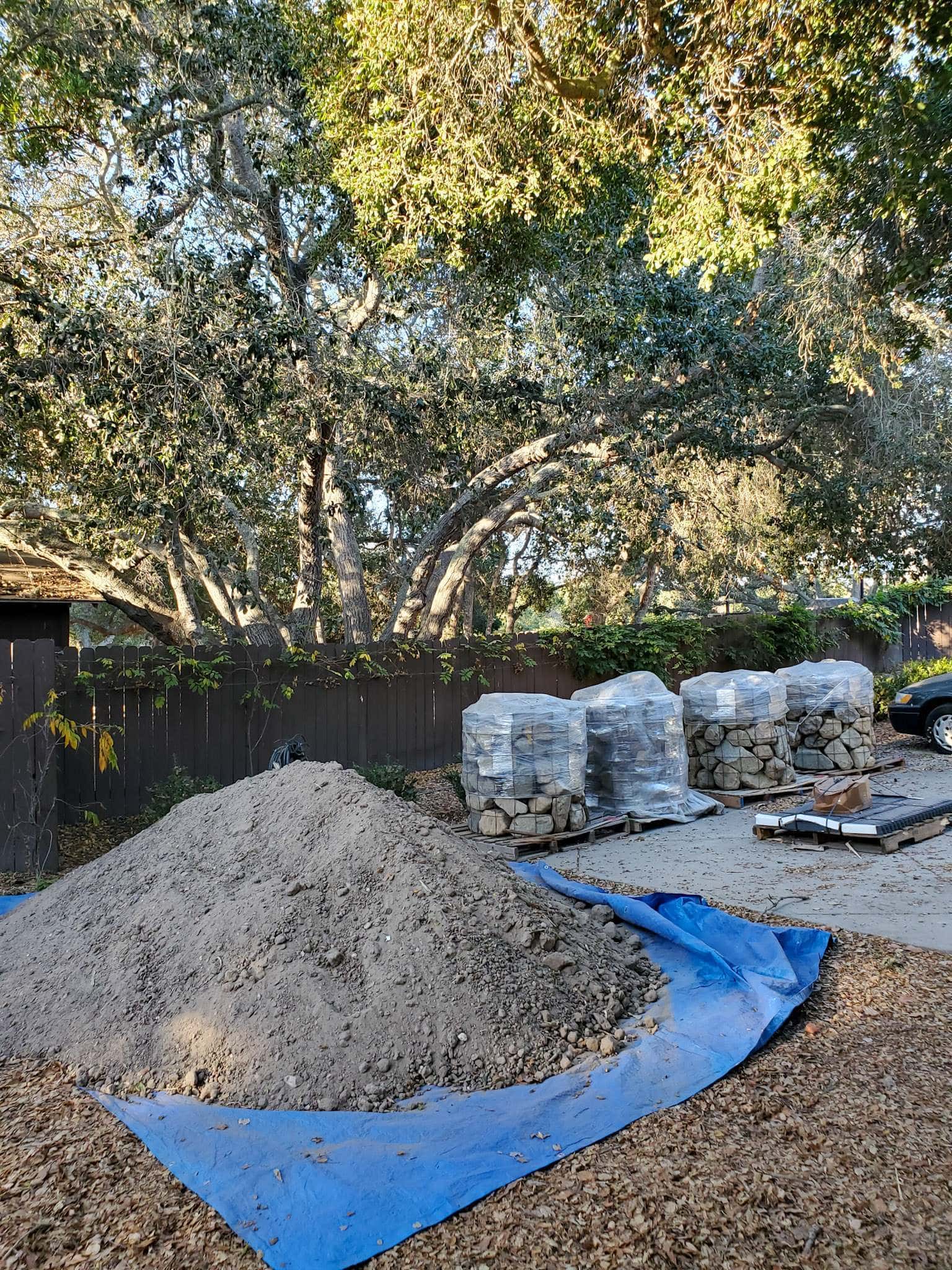



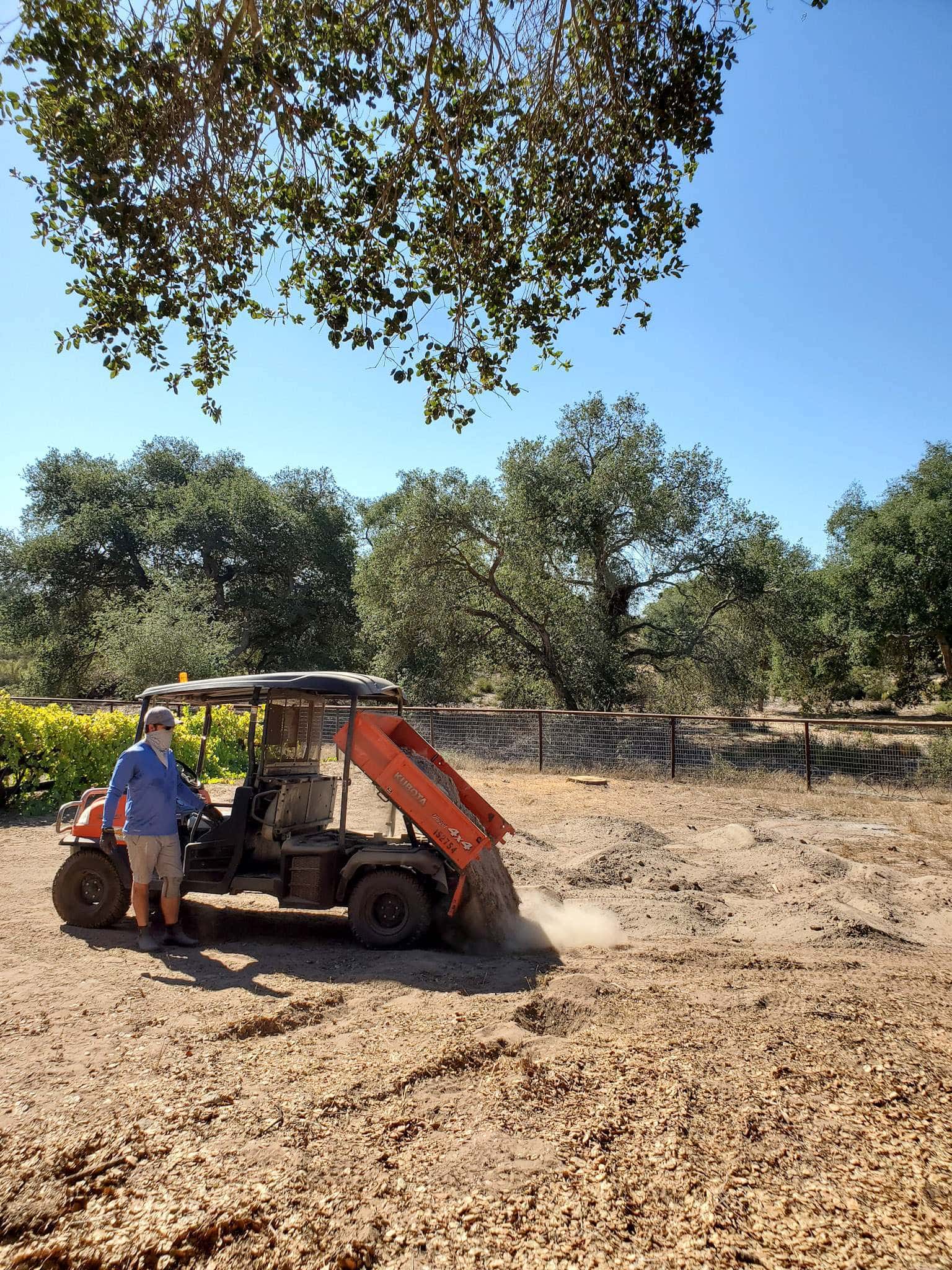
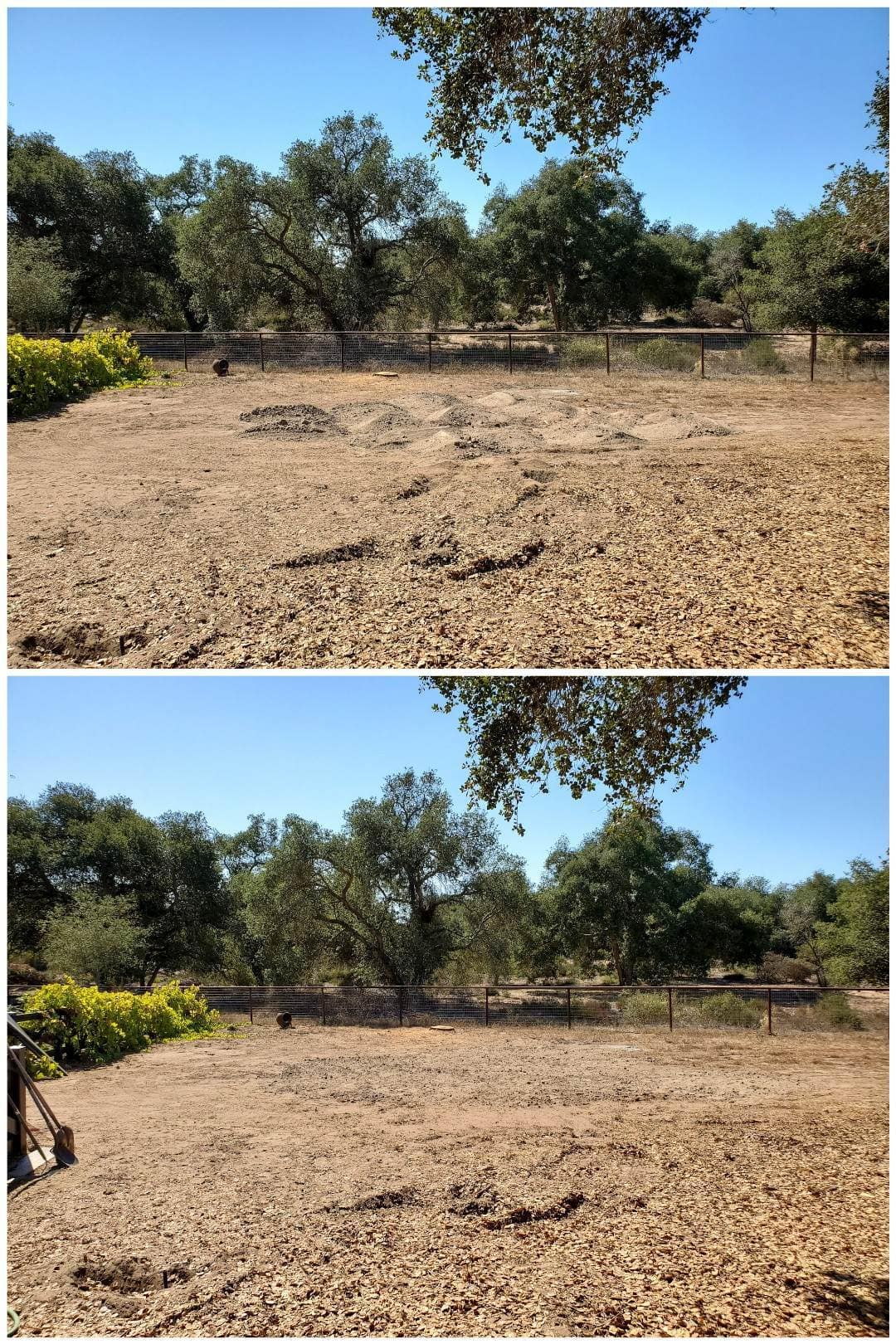
Step 3: Defining the Space
It’s amazing what a little definition can do in a space! As soon as we installed the edging, my vision really started coming to life. All of you following along on Instagram said the same, and also that it made the area look even larger than you first thought.
The plan is to put gravel over the whole space soon (more on that in a moment), along with a long “flower bed” of in-ground plantings and bark mulch along the back side, so we needed a sturdy border that would hold the gravel and mulch in – while also keeping the weeds out.
We chose to use hammer-in steel edging by Edge Right. It’s made of Corten steel, the same stuff sea cargo containers are made of, so it’s incredibly durable and weather-resistant. The metal starts out looking silvery and fresh, but will develop a rustic and protective reddish-brown patina over time. The edging comes in 4-foot pieces, and is available in either a 6-inch or 8-inch deep sizes. Since our soil is very sandy, the folks at Edge Right advised the 8” deep edging was the best option as it would stay most secure in place over time.
Installation was easier and quicker than I anticipated! We did it all in one long weekend, working on it for maybe 2 to 3 hours per day – so about 7 or 8 hours of active install time total for over 350 feet of distance. I am damn proud to say that I did ALL the hammering myself. I am a Cancer and a bit of a perfectionist, so it worked out best for Aaron to hold each piece steady while I hammered them in.
Let’s just say thank goodness for CBD! I have been heavily relying on my favorite organic CBD oil and topical roller to soothe my aching muscles and jostled joints with all this heavy lifting.

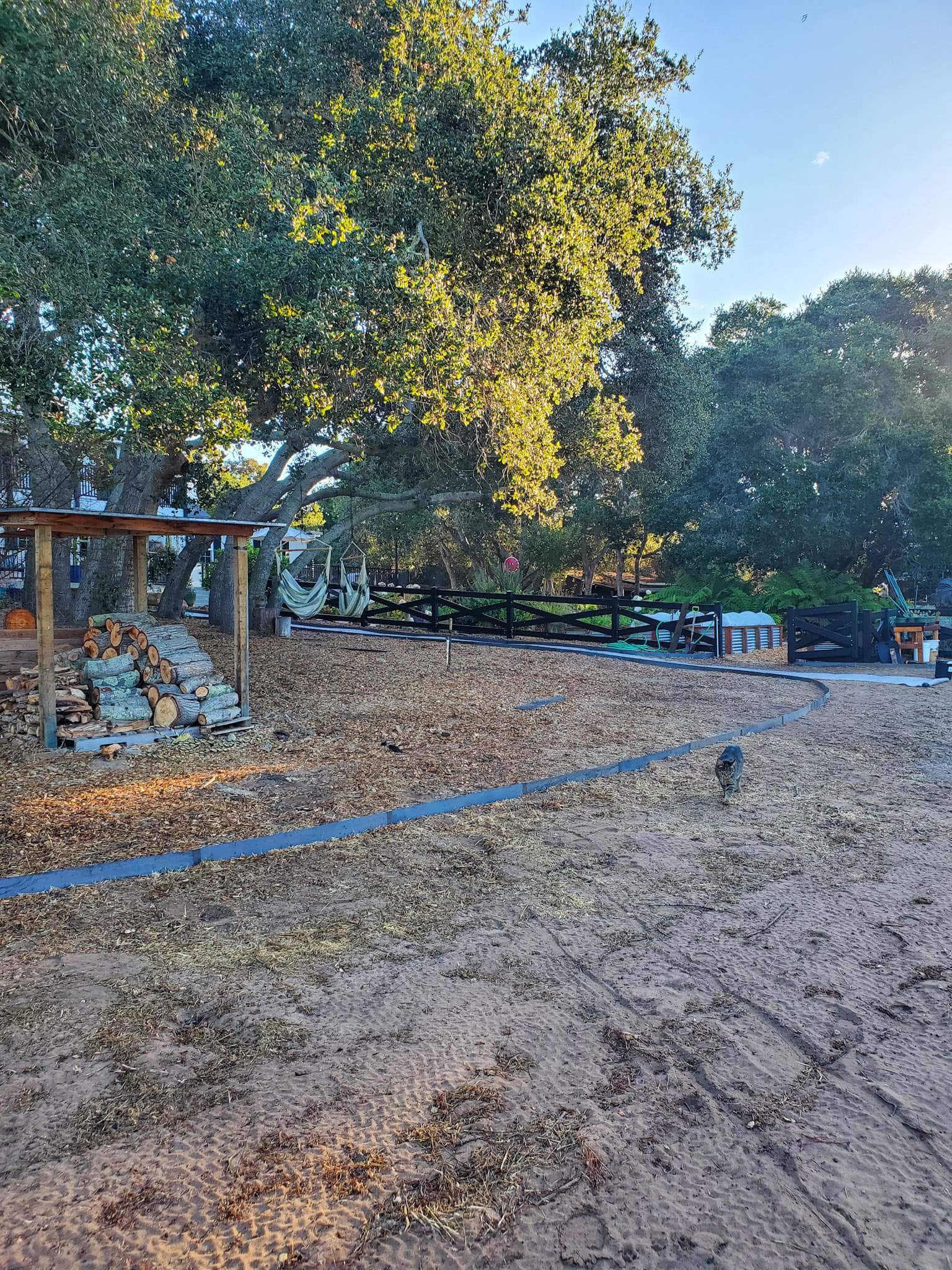
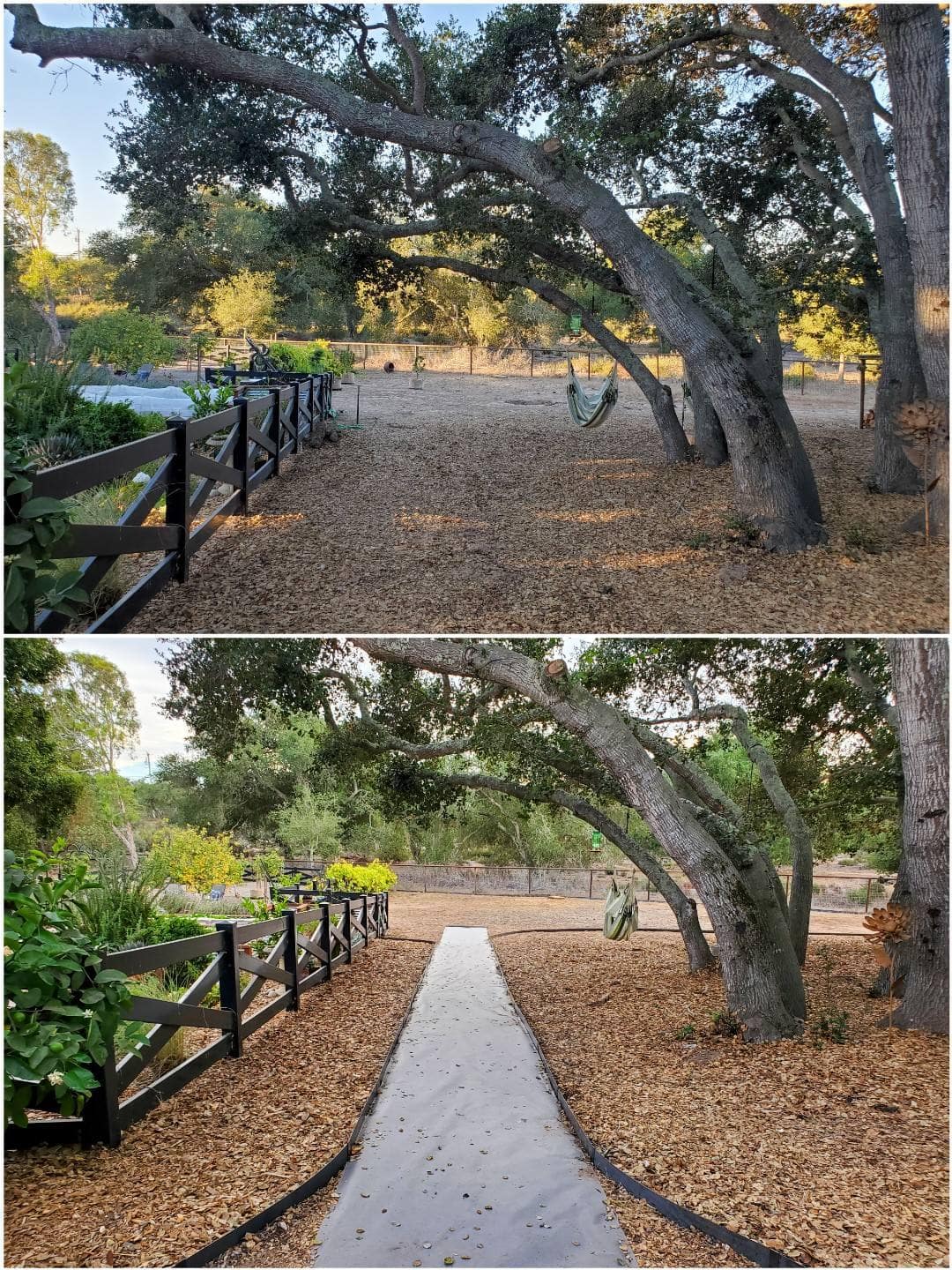
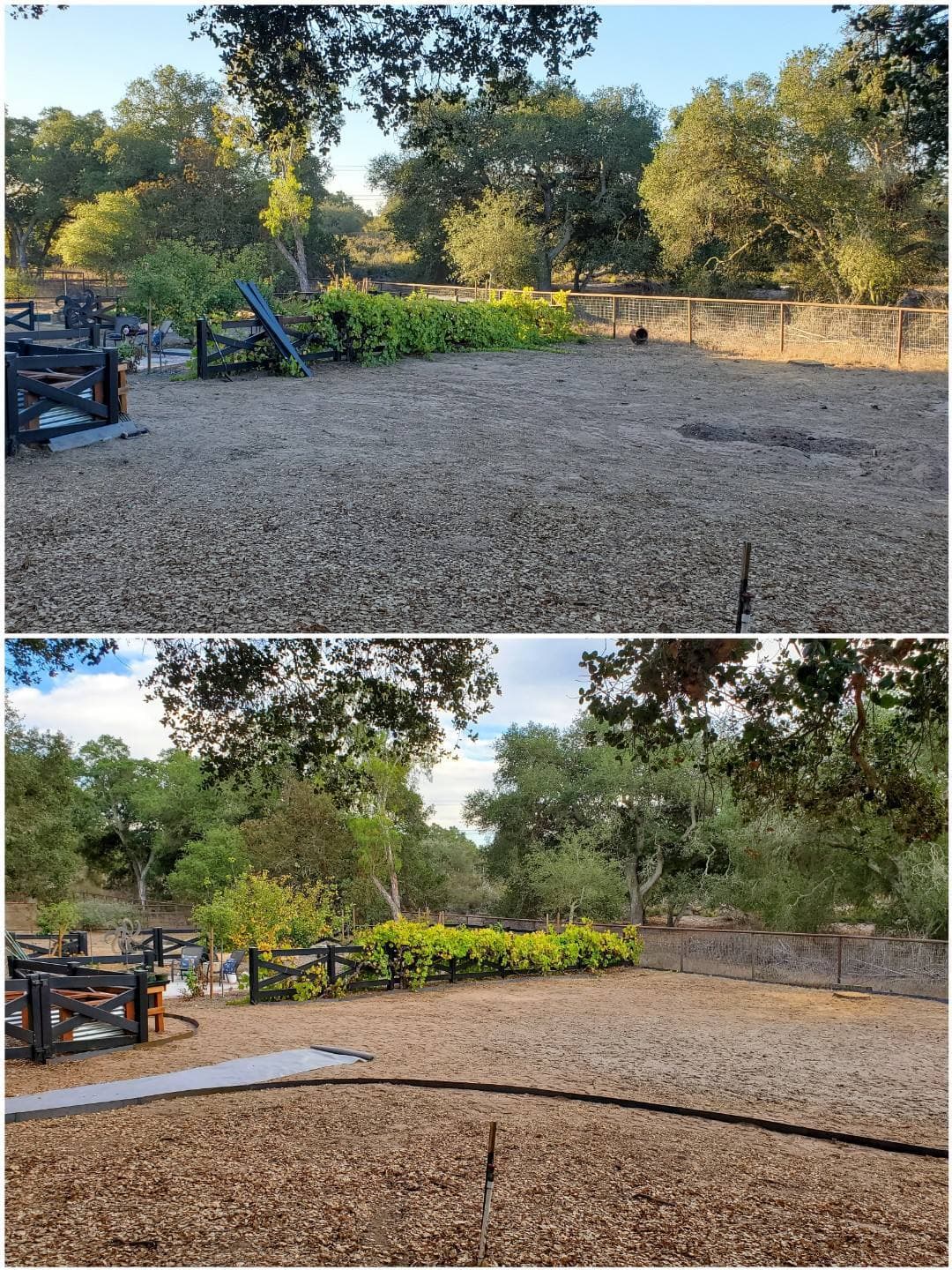

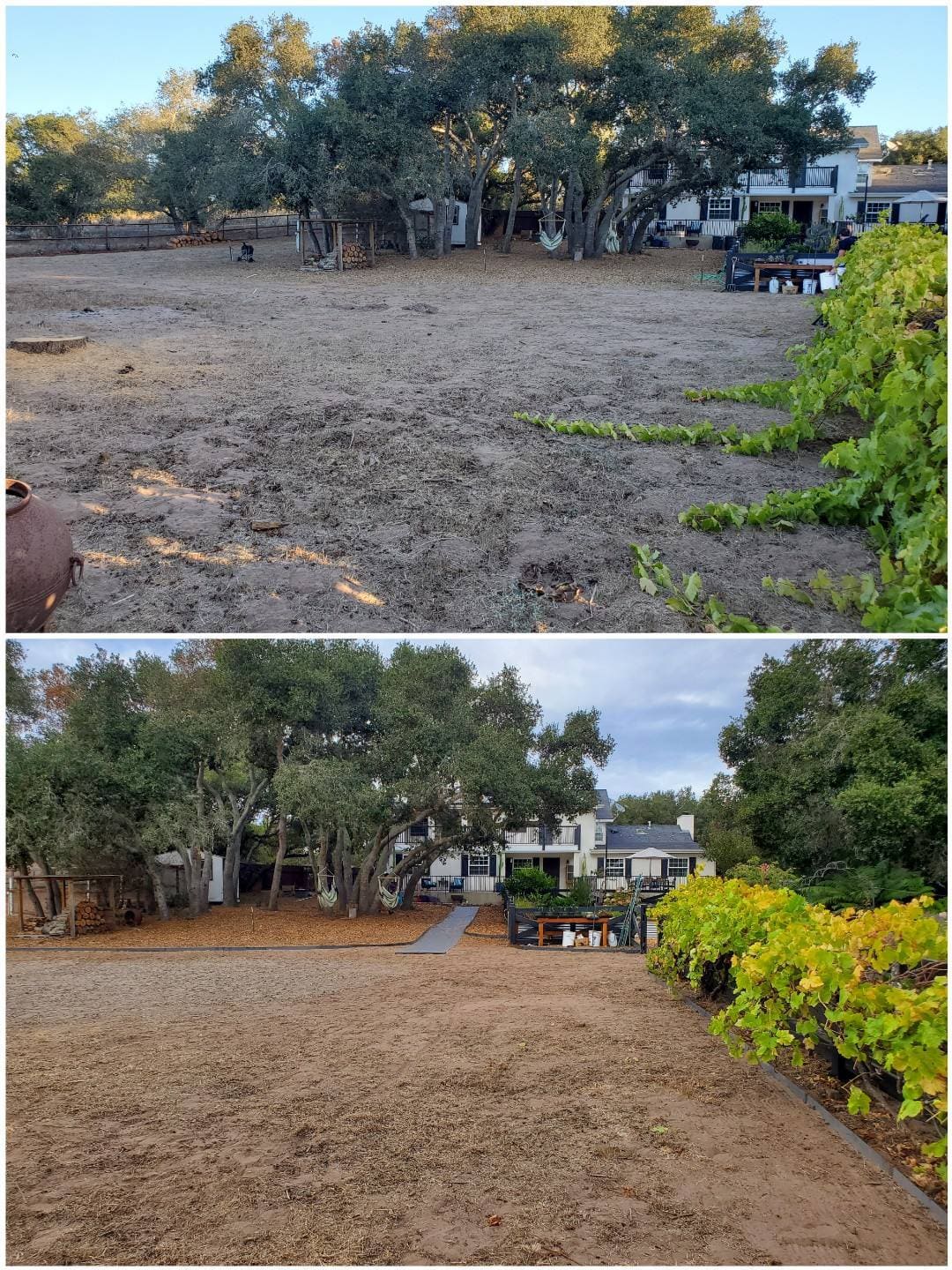
Step 4: Ground Cover
Next, it was time to prep the ground for the gravel to come. Rather than bark or wood chips, we are going to use gravel in our new raised bed garden area for several reasons. 1) I love the clean look of it, and it’s permanence. 2) Gravel will act as a fire barrier between our home and the neighbors wild, dry property of chaparral brush and oaks. Our new property is more rural and has a higher risk for fire than the last, so this was an essential consideration.
Before gravel, we laid down two layers of contractor-grade weed barrier landscape fabric over the entire space. This will provide a long-lasting foundation for the gravel to sit on, as well as block out weeds and gophers.
For the first layer, we used our go-to Landsmaster non-woven commercial weed barrier fabric. It’s the same stuff we used under the raised beds and gravel in our old garden, and does a fantastic job. It keeps out even the most noxious weeds, but is still very lightweight, breathable, and permeable to water. We used to be able to buy it in-store at Home Depot, but lately it has only been available online.
Next, we added a layer of a different type of contractor-grade fabric sourced from a local landscape supply shop that they recommended. It is a thick black woven type with a felt-like underside. Here is a very similar and well-rated product.

Why two layers, you may be wondering? Well, we did two layers of the Landmaster fabric at the old homestead. We were up against incredibly invasive crabgrass in that yard, and we found that it provided an excellent barrier from both weeds and gophers. Plus, the extra layer provided insurance in case one of them accidentally was torn.
Here, we wanted that same durable double-protection, but opted to use two different types of fabric because we need to be able to drive the UTV over the area to move boulders, gravel, wood and soil as we built out the space. The black woven fabric is much heavier, thicker, and stays more taught, so it seemed like the best option for driving over without getting all screwed up in the process.

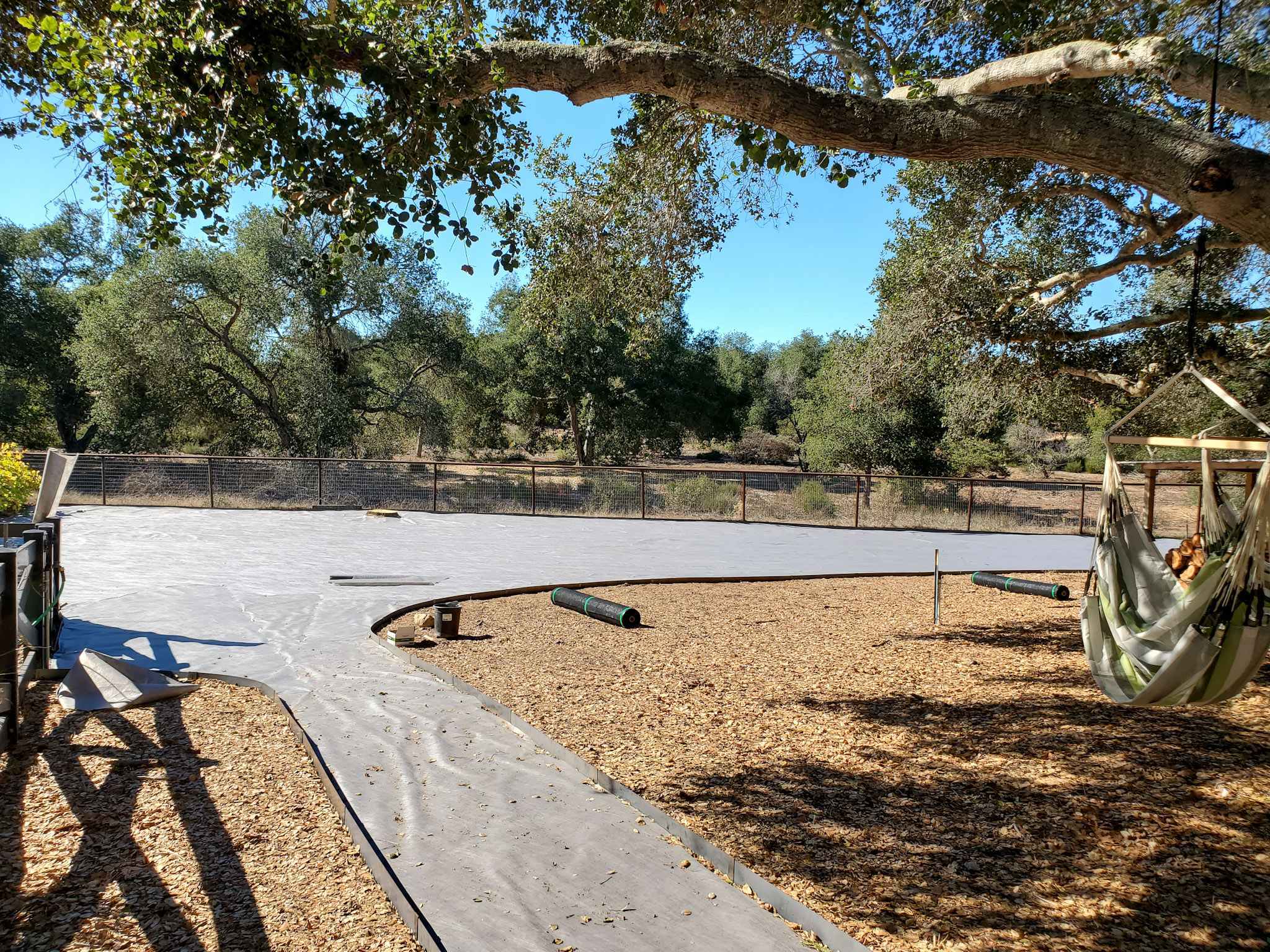
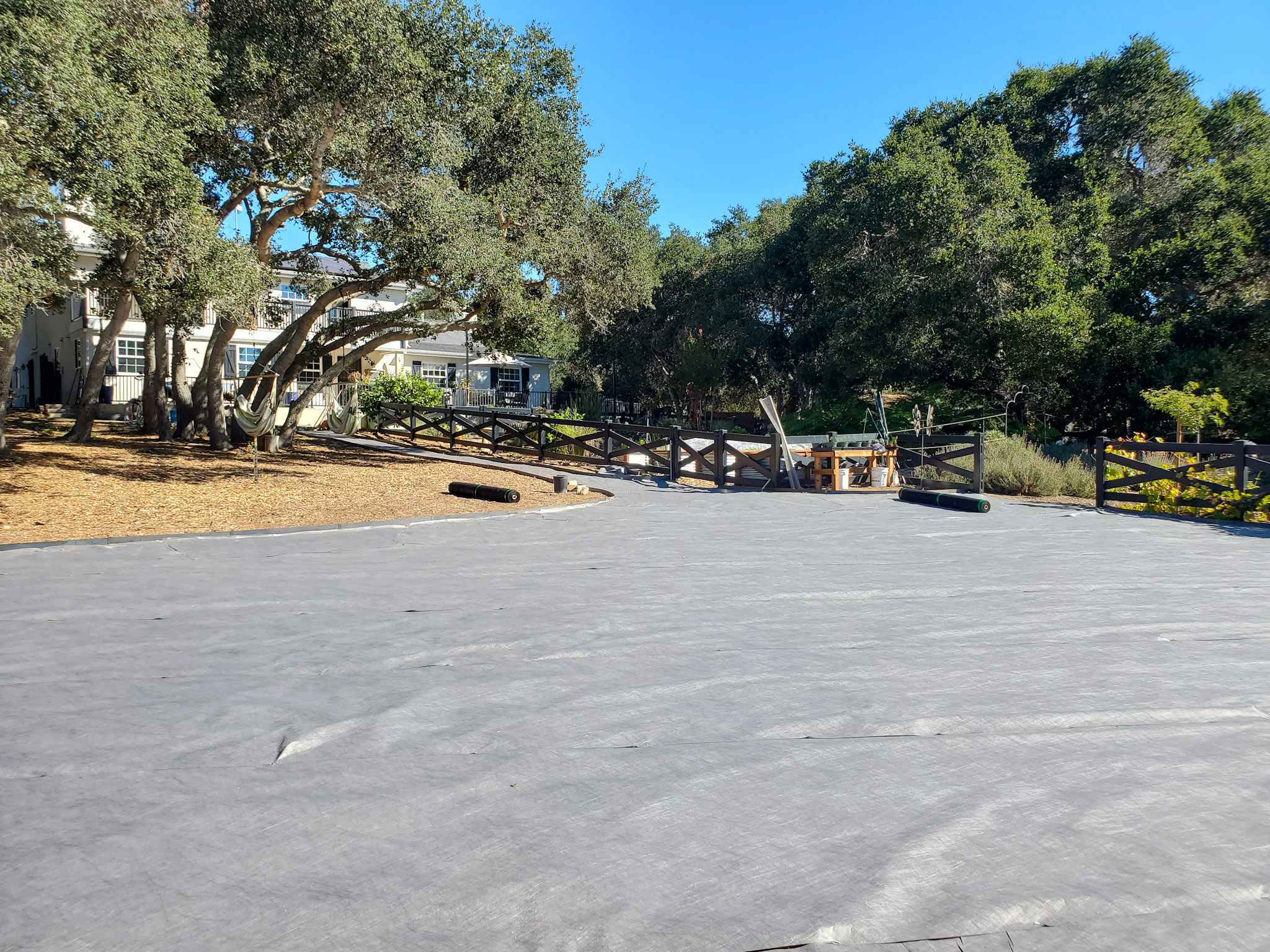

A note on using landscape fabric:
Not all landscape fabric is created equal, nor do I recommend it for every situation! Please avoid the thin, stretchy black plastic-like material you can find at most garden centers. It’s ineffective, rips easily, and makes a hot wasteful mess. Stick with well-rated, heavy-duty contractor grade fabric if you do choose to use it.
However, there are many other more natural materials you can use as ground cover too! For instance, sheet mulching with layers of newspaper or cardboard under a thick layer of wood chips is a great way to suppress weeds in pathways or around flower beds. Or, climates with regular rainfall are ideal for using cover crops to create living green pathways and ground cover. Learn about the pros and cons of 8 different types of mulch here.
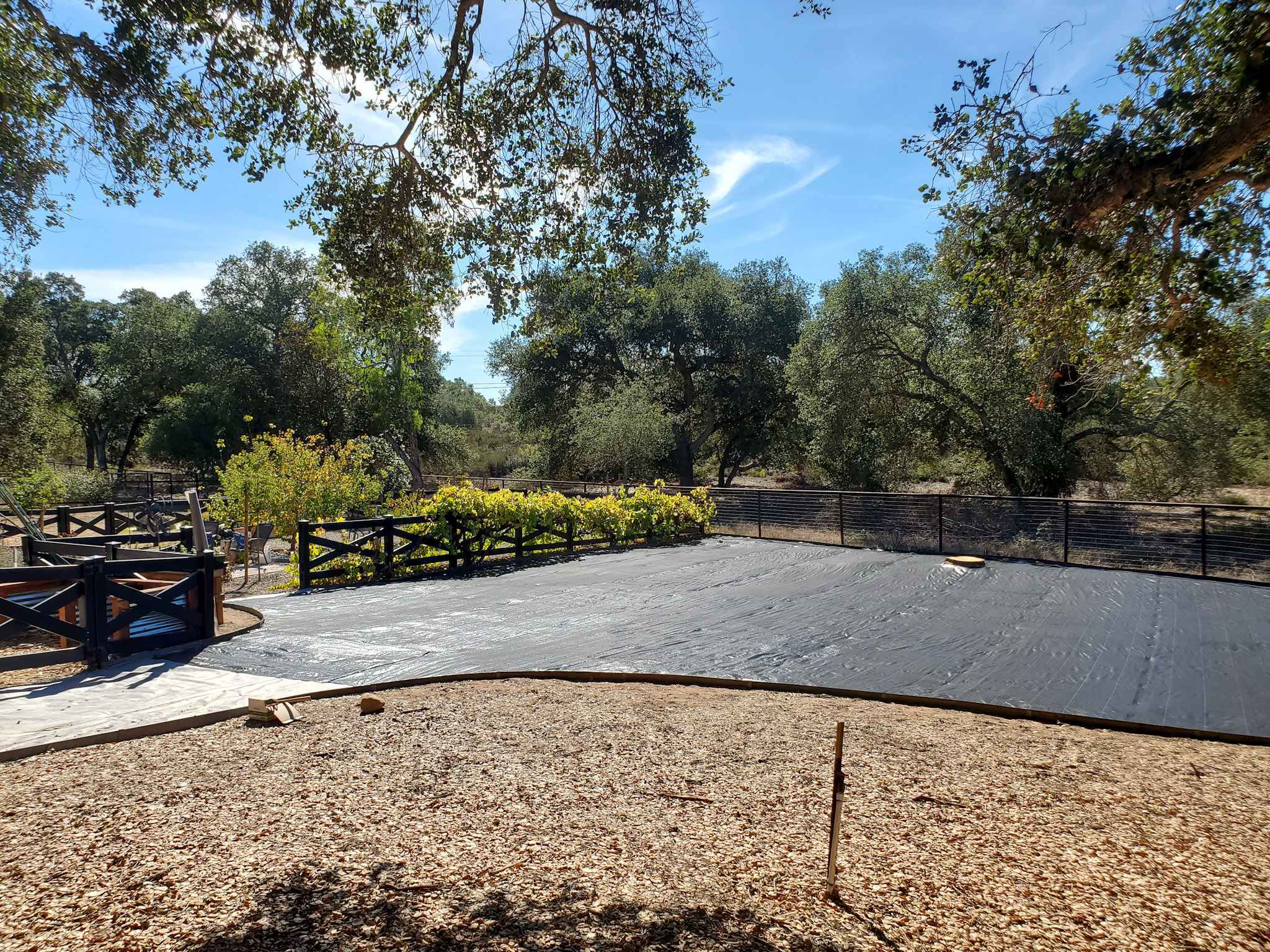

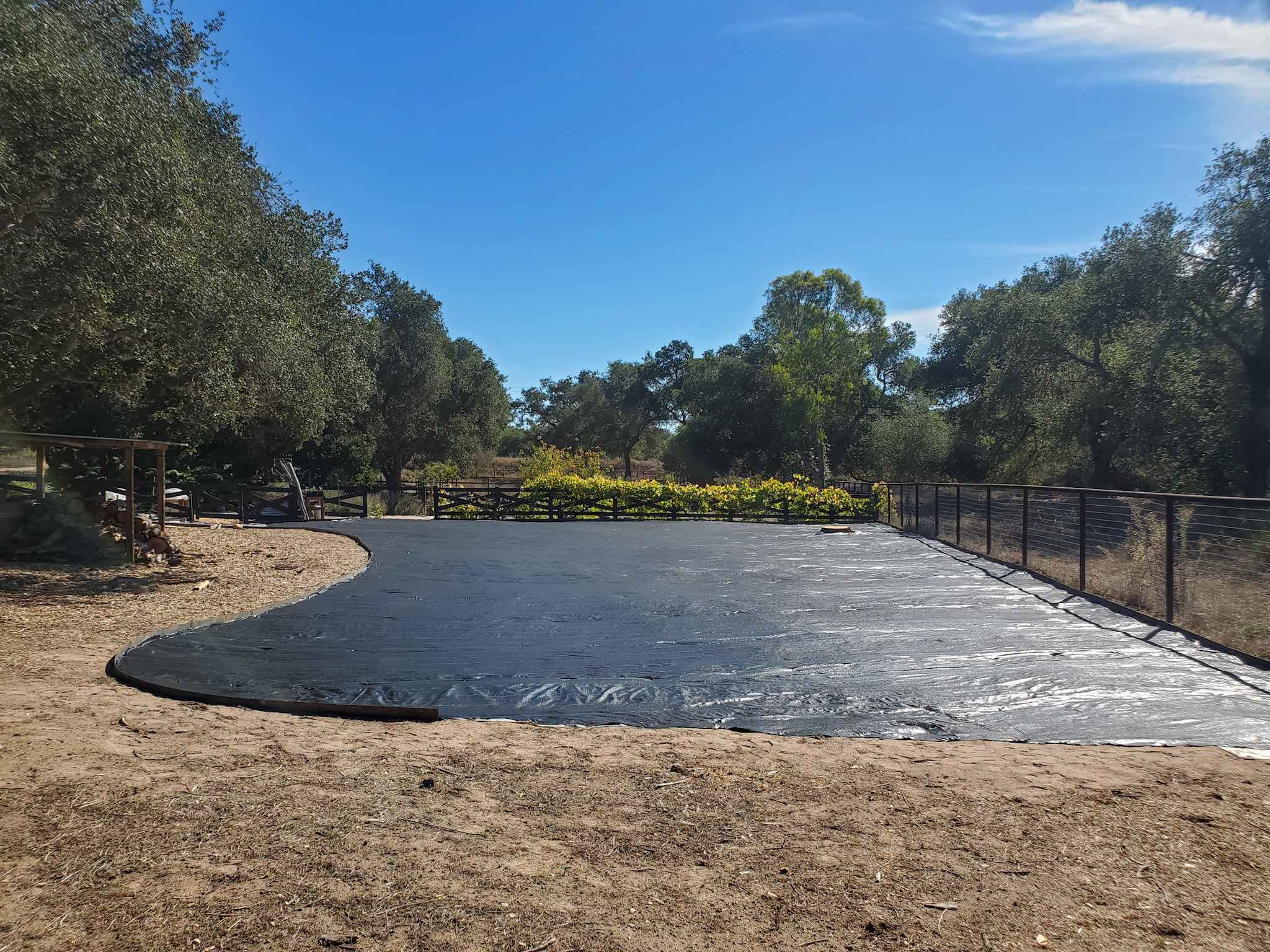
Step 5: Baby Boulders
Once the edging and landscape fabric was in place, we brought in some small landscaping boulders to further define the space and add a whimsical rustic flair. We used the small boulders to line select sections of the pathways and perimeter of the edging, as well as create an additional border between the raised bed area and flower bed that will run behind it along the fence.
One of my IG friends told me their local landscape supplier calls these “BFRs”. I’ll let your imagination fill in what that stands for. 😂 Fitting indeed, since the four pallets we had delivered weighed a total of 10,200 pounds. I was thanking my lucky stars for Dusty the UTV to help us move these too!

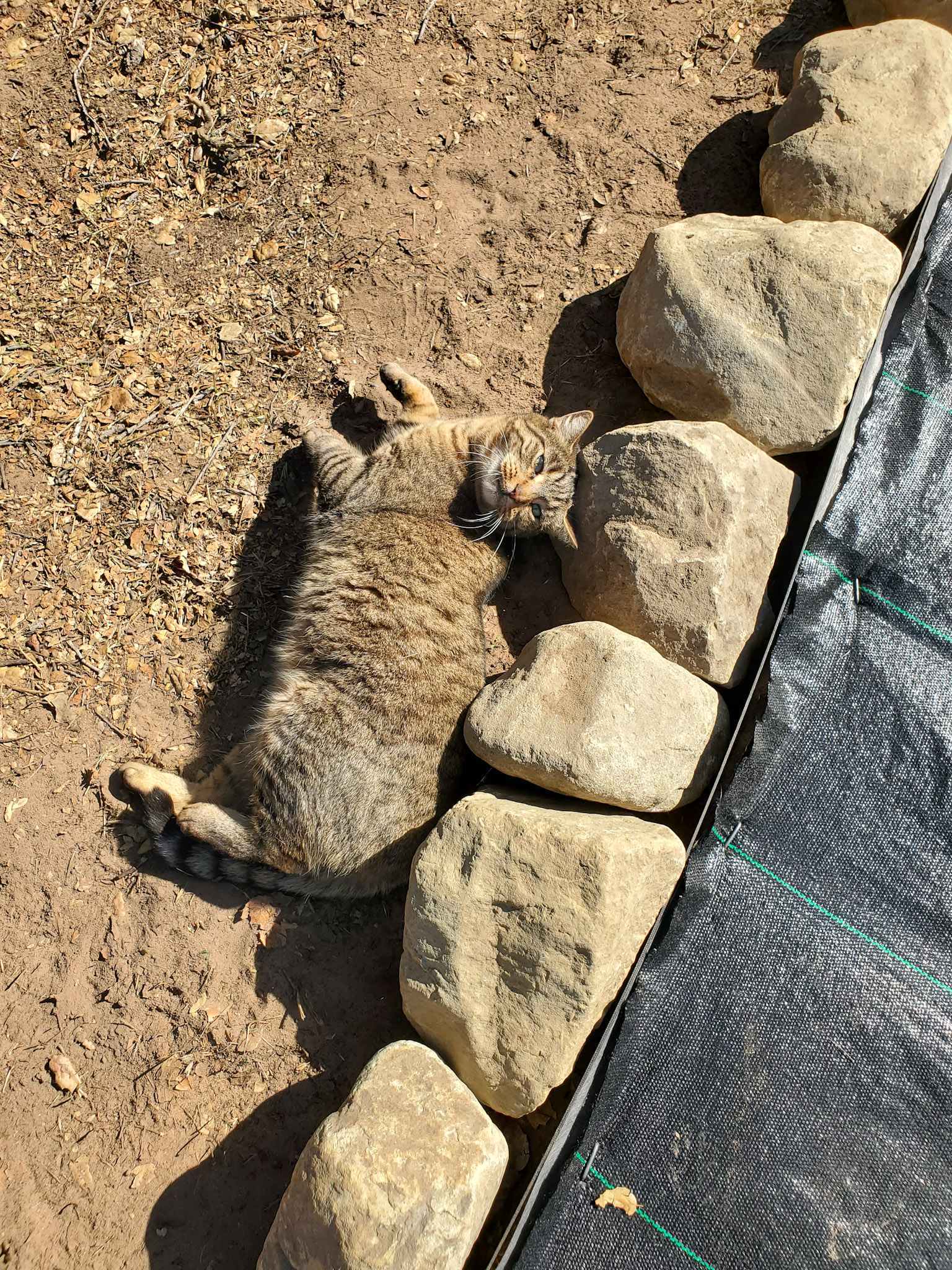


Next Steps
Next up: gravel! We’re currently deliberating between a few different types and colors of gravel to use here. Since we’ll need over 30 yards, we want to be dang sure of our decision before pulling the trigger. The guys at the landscape supply yard suggested taking home 5-gallon buckets of sample rock to lay out, rinse the dirt off, and see how it looks in the space – both wet and dry.
I want something a little more rustic and natural looking than the bright blue-green 3/8″ gravel we used at the old homestead (even though I do love the look of that one). We sampled one called “Navajo” but it was far too red and warm for my liking. So, I think we are going to mix our own! Yesterday we picked up two more samples: a dark green rock, and a warmer gold and grey granite. Together they create a fantastic “salt and pepper” vibe – the perfect blend of warm, cool, light and dark tones.
Color aside, we always use a crushed type of gravel. Due to its angular edges, crushed rock compacts and locks in place really nicely – unlike smoother pea gravel type stones, which sinks and move as you walk on them. (That drives me bananas!)
After the area is filled with gravel, we’ll slowly start adding raised beds. I have plans for dozens of raised beds in this space one day, but we definitely won’t be building and filling them all at once! See our step-by-step guide to build wood raised garden beds, or how we fill raised bed here.
The garden will also have a center courtyard with pavers, various seating, a fountain, and plenty of pretty potted plants, arched trellises, and wine barrel planters speckled across the space too.

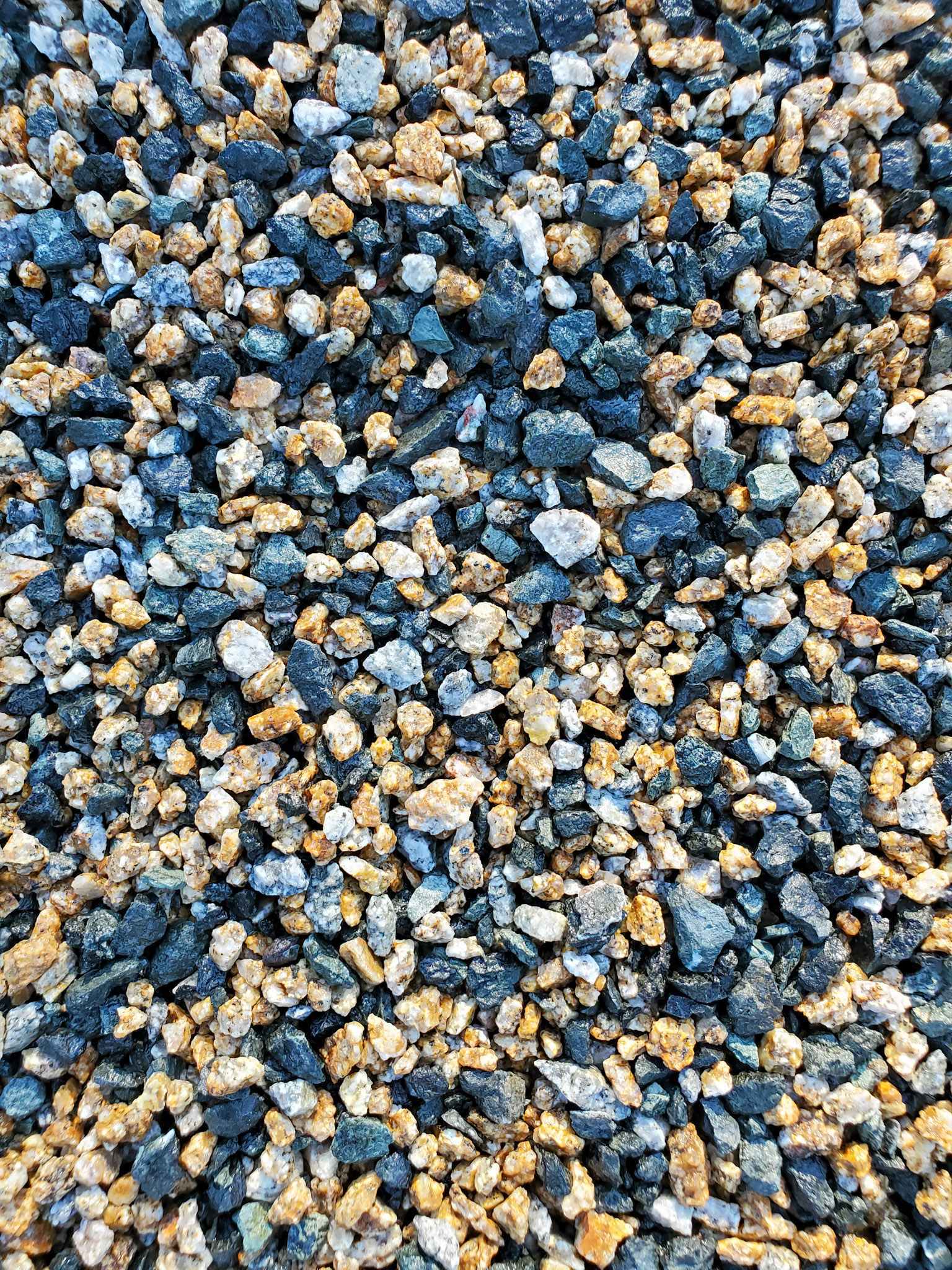
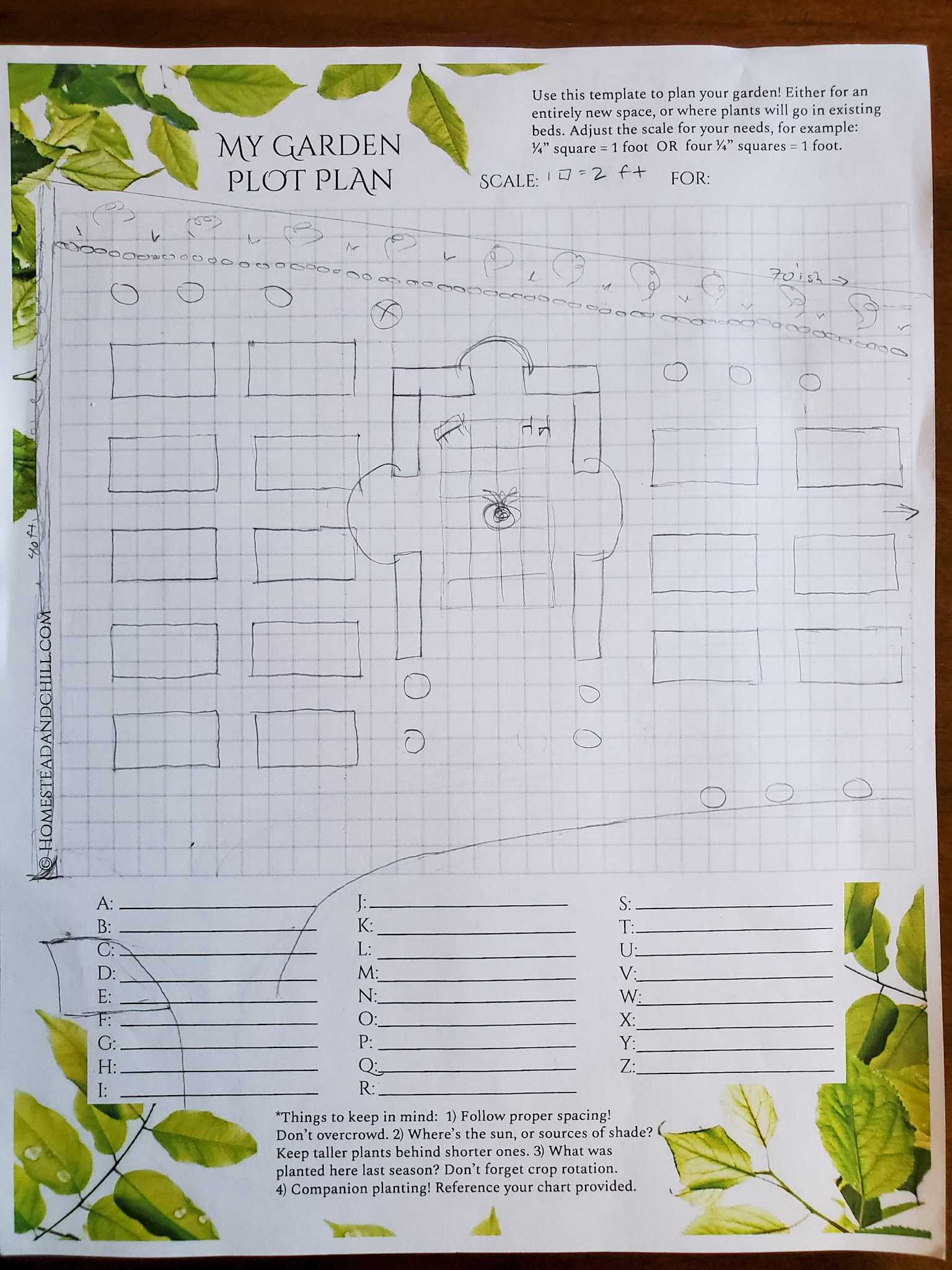

Cheers to good hard work, gardening, and kitty friends!
Wow, are you still with me? Lol… my bad, this update wound up just a wee bit longer than I anticipated. 🤪 But hot dang, I guess we’ve been busy eh?! I promise I won’t wait so long between updates next time, especially when there is so much to share. We sincerely appreciate your interest in our homestead adventures, and hope that you found some value in this post! Stay tuned to see the progress – and see what color gravel we choose!
EDIT: The next steps and full garden reveal are done! Come check out the space after we added gravel, raised beds, arched trellises, plants, and more – tour video included!








37 Comments
Claire Kempner
Hi! How many inches of 3/8″ gravel did you find works best?
Aaron (Mr. DeannaCat)
Hi Claire, we typically go with roughly about 2-3 inches of gravel. Hope that helps and good luck!
Claire Kempner
Thanks Aaron! I really appreciate your quick response!
Stumpy
Do you think the two weed barrier system is good enough for stright over a hefty dead “lawn” of bermuda and crab grass? I am going back and forth if I should I dig out the “lawn” first or just cover it.
It will be heavily mulched with wood chips afterward and the end goal is a nice array of pollinator/edible plants and trees.
Aaron (Mr. DeannaCat)
Hi Stumpy, we were in a similar situation in our old property and we removed the crabgrass beforehand. Check out this article on How to Kill or Remove Grass (& Grow Food Not Lawns!) as we did the same thing and transformed our yard into a pollinator garden and vegetable garden with fruit trees etc. Hope that helps and good luck!
Ian Licata
Hi Aaron and Deanna! My name is Ian and I live in Santa Cruz, My wife and I are planning to pull out our grass and build some raised beds in our back yard and we are inspired by your design! Anyhow we wanted to know if you went with 3/8 gravel again at the new homestead, and also what depth you filled it in, I was planning to do about 4 inches of gravel on top of fabric similar to how you guys did it, but wondering if that is deeper than necessary and also wondering if 3/8 gravel was the size you used. Thanks for all your detailed posts and inspiration for an awesome garden design.
Aaron (Mr. DeannaCat)
Hi Ian, transforming your yard from grass to a garden is a great idea and it will benefit you and your family in more ways than just providing food. We did use 3/8 inch gravel again and we combined a 3/8 gold granite with 3/8 green rock and it is anywhere from 3 to 4 inches deep in spots. You should be good with what you planned as anything deeper than that is excessive but we find 2 inches to be a tad light as well. Hope that helps and good luck to you on this big adventure. Keep us updated on your progress and reach out to us if you have any other questions.
Geely Global
This is a helpful post. Thanks for sharing this post with us.
Gene @The California Table
wowza! such beauty and inspiration! this new homestead is just amazing. I know you say you’re taking it one project at a time, but the pace of development tells me you’re both really good at keeping focused on the big picture as you piece it together. So much to admire! We, similarly, killed off bermuda grass in an area of similar size. But our efforts kinda went bad…so I want to share and help the next person! We live in San Diego, on the coast.
After laying down cardboard then 6″ inches of wood chips, the grass totally died, after about 8 months. BUT there was very little decomposition due to dry winter. Under the chips we had only dead dirt:( Not the increased organic matter and haven for worms that we envisioned.
So we set up raised beds, on top of the chips, with irrigation. BUT we failed to realize water would NOT percolate down through the soil and through the wood chip layer; so our plants drowned in the water-logged beds:( We got nothing from 16 beds (3’x6′).
So we dug up the beds, used the wood to build trellises for our winter garden (peas of all kinds), and planted in mostly dirt but some wood chips were also mixed in. We sadly learned that this made our dirt very fungal and most of the peas died.
Coming back from these failures is taking a lot of thinking and redoing! Hopefully, any readers contemplating a similar effort can learn from our missteps:) If you have any advice to offer, please do:) We are open to advice:)
Looking forward to future reports from your gorgeous homestead!
Aaron (Mr. DeannaCat)
That’s too bad to hear Gene and I am surprised the beds didn’t allow for better drainage and moisture to build up below them. What type of soil did you have in your raised beds and were the raised beds open on the bottom?
Jennifer
I have anxiously awaited your post about your new homestead. We have an 8 acre property so I live through you to be honest. You both have such energy & vision it is inspriring. Please know you are uplifting & inspiring many who read your posts. I LOVE all the pics!! And yes, even semi-ferel cats eventually come around. I think they already love you both more…you must be waaaaaay more active than their old owners! 😉 They reminded me of our 6 barn cats in your pics here…always the attention seekers. Thanks for what you both do!!
Aaron (Mr. DeannaCat)
Thank you so much for the kind words Jennifer! Having a larger property can be overwhelming at times but it is best to take things one step at a time and that’s what we try and do. It is fun to have cats outside as we’ve only had indoor cats but we appreciate the companionship when were outdoors in the garden. We’re glad you can find inspiration in our work and articles and we appreciate your support!
Kayjmac
Y’all continue to give me so many ideas, I don’t know where to start! (That’s not a bad thing, lol.) I was sad to see you leave your old gardens and all that work, but happy to see how you’re transforming this new space. I love that your husband refers to himself as Mr. DeannaCat, very endearing. You two are so inspiring together. Love y’alls attitude, keep up the good work! Thanks!
Kayjmac
Heather
We are kindred spirits, that’s for sure!!! I’m being supervised by my grey and whit whisker-boss as I write! Question for you: the steel sides of the raised planters.: how are they secured to the wood posts? I inherited raised beds, but I think they were made with treated lumber, and I’d rather avoid heavy metal poisoning…. steel looks like a great solution. Easily available in my rural Candy location. We are waiting for our first snow here, so I cannot tell you how much I live through your plantings of avocados, persimmons, pomegranates and lemons…. ahhhh…. I di try figs, as we have a few hardy varieties, but I didn’t winter store them properly… weeep.
Anyway, hugs, and keep on keeping on. Love it!
Aaron (Mr. DeannaCat)
Hi Heather, it’s good to see your cat has taken on that role and it’s funny how easy they fall into it! We did not build the wood/metal raised beds as they were here when we bought the property. I would imagine the corrugated steel is drilled into the wooden frame from the inside of the bed towards the outside. There are 2×4’s used in the corners and along the sides of the beds every so often, using screws along each section of wood would seem to make the bed and sides fairly stable. Hope the winter doesn’t come too soon for you and sorry about your fig trees, don’t be afraid to give them another chance when you have time. Good luck on building some new raised beds and let us know if you have any questions going forward.
Heather Cullen
Hi Gardeners!
Thanks for that reply, Aaron, about steel raised beds. So maybe I asked the wrong question! Would you recommend steel for raised beds? I wonder about heating, freezing cycles as I live in Canada. I started to rethink the steel idea. What is your ideal raised planter gardening material? I realize as I ask this that you’ve probably amply answered this about your previous property. But now that you’ve moved and are starting from scratch, what’s best? Please feel free to point me to a previous post.
All best, Heather
Aaron (Mr. DeannaCat)
Hi Heather, I would recommend galvanized steel raised beds if that is what you prefer, they are quite popular and may not moderate the soil temperature as well during winter but you may not be growing much during these months depending on where you are in Canada anyways. We prefer to make our raised beds out of redwood (or cedar for places where it is more available), but areas with more wet and rainy conditions may find wood to rot faster. Check out this article if you need some more ideas: Choosing the Best Materials for Raised Garden Beds. Hope that helps, let us know if you have any other questions and good luck!